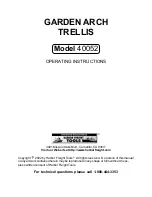
2.1
American National Standards Institute (ANSI) and Occupational Safety and Health Administration (OSHA):
The SRD discussed in this
manual meets the standards of ANSI Z359.14-2021, ANSI A10.32-2012, and Occupational Safety and Health Administration (OSHA)
regulations 1926.502 and 1910.140. ANSI requires SRDs be classified according to the type of usage the user would be exposed to, and are
tested either as Class 1 or Class 2. Dynamic performance means that the SRD is installed in a testing drop tower. A test weight is attached
to the SRD and then dropped. Test results are recorded.
Parameters recorded are:
The Arrest Distance is the total vertical distance required to arrest a fall. The Arrest Distance includes the deceleration distance and the
activation distance. The Average Arrest Force is the average of the forces applied to the body and the anchorage by the fall protection
system. The Maximum Arrest Force is the maximum amount of force that may be applied to the body and the anchorage by the fall
protection system. In addition to the above tests conducted in ambient conditions, the units must be retested for average and peak forces
under certain environmental conditions, where the units are cooled, then tested, heated, then tested, or saturated in water and tested
again. Separate units may be used for each test. All test results are recorded.
This test data is then used to establish the basis for fall clearance guidelines published in the user instruction manual.
Class 1 and 2:
Class 1 devices shall be used only on overhead anchorages and shall be subjected to a maximum free fall of 2 feet
(0.6 m) or less. Class 2 devices are intended for applications where an overhead anchorage may not be available or feasible and be
subjected to a free fall of no more than 6 feet (1.8 m) over an edge.
To be declared a Class 1 and Class 2 device, ANSI requires an SRD to have an overhead Arrest Distance of less than 42” (1.1 m), an Average
Arrest Force of less than 1,350 lbs (6 kN) [1,575 lbs (7 kN) conditioned] and a Maximum Arresting Force of 1,800 lbs (8 kN), for both
ambient and conditioned testing.
When dynamically tested in accordance with requirements of ANSI Z359.14-2021, FallTech Class 1 and Class 2 Self-Retracting Devices have
an AAF of 1,350 lbs (6 KN) or less and an AD of less than 42” (1.1 m).
Please see Section 5 of this user instruction manual for how to calculate your Minimum Required Fall Clearance (MRFC).
Class 2 SRLs shall include labels illustrating a fall clearance table and a diagram of the axes shown on the table. These labels shall be
affixed to the product. The DuraTech Leading Edge includes these labels in the Energy Absorber.
Please see Section 5.2 of this user instruction manual for how to calculate your Minimum Required Fall Clearance (MRFC) using the
affixed labels.
Classification information found on product labels is based on test results. Table 1B provides test performance results for the SRD
discussed in this manual. NOTE: Arrest distance is one of several parts of the Minimum Required Fall Clearance (MRFC). MRFC is discussed
in detail in Section 5 .
OSHA requires an SRD limit the free fall to 2 feet (0.9 m) or less. If the maximum free fall distance must be exceeded, the employer must
document, based on test data, that the maximum arresting force will not be exceeded, and the personal fall arrest system will function
properly. The SRD discussed in this manual was successfully tested for horizontal use and falls over a steel edge without burrs, as found
on steel shapes and metal sheeting, and may be used in situations where a fall may occur over similar edges, such as found on steel
shapes or metal sheeting.
•
Arrest Distance (AD)
•
Average Arrest Force (AAF)
•
Maximum Arrest Force (MAF)
MSRD28 Rev B
081723
5






































